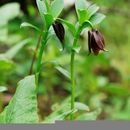en
names in breadcrumbs


Flowering from May to July; fruiting from August to October.
Fritillaria cirrhosa is close relative of Fritillaria cirrhosa, but differs from the latter in its nectaries elliptic to ovate, 3-5 mm long, 2-3 mm wide (vs. suborbicular, ca. 2 mm long, 2 mm wide), filaments sometimes papillose (vs. glabrous).
Fritillaria cirrhosa is occurring in Gansu, Qinghai, Sichuan, Xizang, Yunnan of China, Bhutan, India, Nepal, Sikkim.
Bulb of 2 scales, 1-2 cm in diameter. Stem 15-60 cm tall. Leaves 7-11, opposite or sometimes also 3-4-whorled and alternate; leaf blade linear to linear-lanceolate, 4-12 cm long, 3-8 mm wide, apex often curved or cirrose. Inflorescence 1-3-flowered; bracts 3, apex curved or cirrose. Flower nodding, campanulate or narrowly so; pedicel much shorter than tepals. Tepals yellow or yellowish green, slightly or heavily spotted or tessellated with purple, usually oblong-elliptic, 3-5 cm long, 1.2-1.7 cm wide; nectaries elliptic to ovate, 3-5 mm long, 2-3 mm wide, projecting abaxially. Stamens 2-3 cm long; filaments sometimes slightly papillose. Style 3-lobed; lobes 3-5 mm long. Capsule narrowly winged; wings 1-1.5 mm wide.
The chromosomal number of Fritillaria cirrhosa is 2n = 24 (Chatterjee, 1971; Roy et al, 1988; Xie et al., 1992).
Growing in forests, alpine thickets, meadows, flood lands, moist places; 3200-4500 m.
The bulbs of Fritillaria cirrhosa are used medicinally.
Fritillaria cirrhosa, common name yellow Himalayan fritillary,[2] is an Asian species of herbaceous plant in the lily family, native to China (Gansu, Qinghai, Sichuan, Tibet, Yunnan), the Indian Subcontinent (Nepal, Pakistan, India, Bhutan), and Myanmar.[3][4]
Fritillaria cirrhosa produces bulbs up to 20 mm (0.8 in) in diameter. The stem is up to 60 cm (24 in) tall, usually with one flower at the top, sometimes two or three. Leaves are narrowly lanceolate, usually opposite, sometimes whorled, up to 13 cm (5.1 in) long. Flowers are bell-shaped, yellowish-green to brownish-purple flowers which are usually with a chequered pattern in dull purple. The plant is commonly found in alpine slopes and shrublands of the Himalayas, at altitudes of 2,700–4,000 m (9,000–13,000 ft).[4][5][6][7] It is in danger of extinction, due to be being aggressively collected to make a traditional Chinese medicine, Bulbus fritillariae cirrhosae.[8]
Several names have been coined at infraspecific levels (variety, subspecies, and form) for plants once believed to belong to Fritillaria cirrhosa. None of these is currently recognized. Some of the names are regarded as synonyms of Fritillaria cirrhosa not deserving recognition (see synonym list at right). A few others are considered as belonging to distinct species. Those are:
Fritillaria cirrhosa, common name yellow Himalayan fritillary, is an Asian species of herbaceous plant in the lily family, native to China (Gansu, Qinghai, Sichuan, Tibet, Yunnan), the Indian Subcontinent (Nepal, Pakistan, India, Bhutan), and Myanmar.
Fritillaria cirrhosa produces bulbs up to 20 mm (0.8 in) in diameter. The stem is up to 60 cm (24 in) tall, usually with one flower at the top, sometimes two or three. Leaves are narrowly lanceolate, usually opposite, sometimes whorled, up to 13 cm (5.1 in) long. Flowers are bell-shaped, yellowish-green to brownish-purple flowers which are usually with a chequered pattern in dull purple. The plant is commonly found in alpine slopes and shrublands of the Himalayas, at altitudes of 2,700–4,000 m (9,000–13,000 ft). It is in danger of extinction, due to be being aggressively collected to make a traditional Chinese medicine, Bulbus fritillariae cirrhosae.